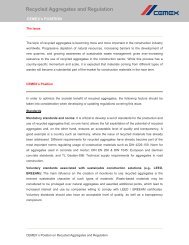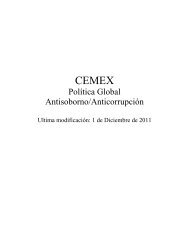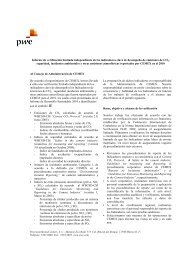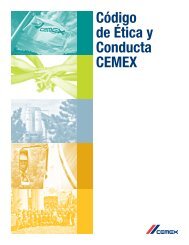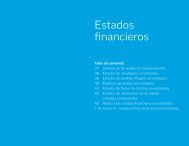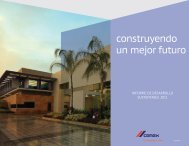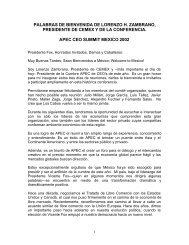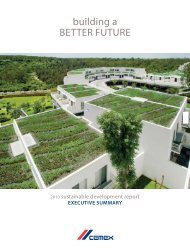building a STRONGER foundation - Cemex
building a STRONGER foundation - Cemex
building a STRONGER foundation - Cemex
Create successful ePaper yourself
Turn your PDF publications into a flip-book with our unique Google optimized e-Paper software.
In 2007, the EPA launched a CAA enforcement initiative against the U.S. cement industry. The primary goal of the initiative is<br />
to assess the industry’s historic compliance with the CAA’s New Source Review program and to reduce emissions from the industry<br />
through the installation of add-on controls. CEMEX has actively engaged with the EPA on its investigations, which involve multiple<br />
CEMEX facilities, and has entered into two settlements involving a total of $3.4 million in civil penalties and a commitment to incur<br />
certain capital expenditures for pollution control equipment at its Victorville, California and Fairborn, Ohio plants. Although some of<br />
these proceedings are still in the initial stages, based on our past experience with such matters and currently available information, we<br />
believe, although we cannot assure you, that such cases will not have a material impact on our business or operations.<br />
In 2002, CEMEX Construction Materials Florida, LLC (formerly Rinker Materials of Florida, Inc.) (“CEMEX Florida”), a<br />
subsidiary of CEMEX, Inc., was granted a federal quarry permit and was the beneficiary of another federal quarry permit for the Lake<br />
Belt area in South Florida. The permit held by CEMEX Florida covered CEMEX Florida’s SCL and FEC quarries. CEMEX Florida’s<br />
Kendall Krome quarry is operated under the permit of which it was a beneficiary. The FEC quarry is the largest of CEMEX Florida’s<br />
quarries measured by volume of aggregates mined and sold. CEMEX Florida’s Miami cement mill is located at the SCL quarry and is<br />
supplied by that quarry, while the FEC and Kendall Krome quarries have supplied aggregates to CEMEX and third party users. In<br />
response to litigation brought by environmental groups concerning the manner in which the federal quarry permits were granted, in<br />
January 2009, the U.S. District Court for the Southern District of Florida ordered the withdrawal of the federal quarry permits of<br />
CEMEX Florida’s SCL, FEC and Kendall Krome quarries. The judge ruled that there were deficiencies in the procedures and analysis<br />
undertaken by the Army Corps of Engineers, or the Corps, in connection with the issuance of the permits. Upon appeal, on January 21,<br />
2010, the Eleventh Circuit Court of Appeals affirmed the district court’s ruling withdrawing the federal quarry permits of the three<br />
CEMEX Florida quarries as well as other third-party federal quarry permits subject to the litigation. On January 29, 2010, the Corps<br />
completed a multi-year review commenced as a result of the above-mentioned litigation and issued a Record of Decision (ROD)<br />
supporting the issuance of new federal quarry permits for the FEC and SCL quarries. Excavation of new aggregates was stopped at the<br />
FEC and SCL quarries from January 20, 2009 until new permits were issued. The FEC permit was issued on February 3, 2010, and the<br />
SCL permit on February 18, 2010. The ROD also indicated that a number of potential environmental impacts must be addressed at the<br />
wetlands located at the Kendall Krome site before a new federal quarry permit may be issued for mining at that quarry. It is unclear<br />
how long it will take to fully address the Corps’ concerns regarding mining in the Kendall Krome wetlands. While no new aggregates<br />
will be quarried from wetland areas at Kendall Krome pending the resolution of the potential environmental issues, the FEC and SCL<br />
quarries will continue to operate. If CEMEX Florida were unable to maintain the new Lake Belt permits, CEMEX Florida would need<br />
to source aggregates, to the extent available, from other locations in Florida or import aggregates. This would likely affect operating<br />
income from our Florida operations. Any adverse impacts on the Florida economy arising from the cessation or significant restriction<br />
of quarrying operations in the Lake Belt area could also have a material adverse effect on our financial results.<br />
Europe. In Great Britain, future expenditure on closed and current landfill sites has been assessed and quantified over the period<br />
in which the sites are considered to have the potential to cause environmental harm, generally consistent with the regulatory view of<br />
up to 60 years from the date of closure. The assessed expenditure relates to the costs of monitoring the sites and the installation, repair<br />
and renewal of environmental infrastructure. The costs have been quantified on a net present value basis in the amount of<br />
approximately £130.2 million (approximately U.S.$216.6 million as of April 30, 2011, based on an exchange rate of £0.6010 to<br />
U.S.$1.00) as of December 31, 2010, and we made an accounting provision for this amount at December 31, 2010.<br />
In 2003, the European Union adopted a directive in order to help it fulfill its commitments under the Kyoto Protocol on climate<br />
change. This directive defines and establishes a GHG emissions allowance trading scheme within the European Union, i.e., it caps<br />
carbon dioxide emissions from installations involved in energy activities, the production and processing of ferrous metals, the cement<br />
and lime industries and the pulp, paper and board production businesses. Installations in these sectors have to monitor their emissions<br />
of CO2 and surrender every year allowances (the right to emit one metric ton of CO2) that cover their emissions. Allowances are<br />
issued by member states according to their National Allocation Plans, or NAPs. The NAPs not only set the total number of allowances<br />
for a given phase, but also define how they are allocated among participating installations. So far most allowances have been allocated<br />
for free, but some member states sell up to 10% of their total allowance volume in auctions or on exchanges. Allowances are tradable<br />
so as to enable companies that manage to reduce their emissions to sell their excess allowances to companies that exceed their<br />
allocated quota. Failure to meet the emissions caps can subject a company to heavy penalties.<br />
Companies can also use credits issued under the flexible mechanisms of the Kyoto protocol to fulfill their European obligations.<br />
Credits for emission reduction projects obtained under these mechanisms are recognized, up to specified levels, under the ETS as<br />
allowances substitutes. The main source of those credits are projects registered under the so-called Clean Development Mechanism<br />
(“CDM”), but Joint Implementation (“JI”) credits are also eligible; the difference between these credits is dependent on which country<br />
is hosting the project: CDM projects are implemented in developing countries, JI projects in developed ones.<br />
70



